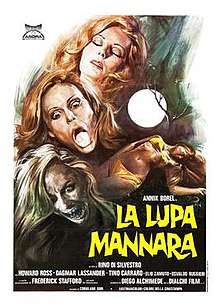Werewolf Woman
Werewolf Woman (Italian: La lupa mannara) is a 1976 Italian horror film directed by Rino Di Silvestro.[2][3]
| Werewolf Woman | |
|---|---|
 Theatrical release poster | |
| Directed by | Rino Di Silvestro |
| Produced by | Diego Alchimede[1] |
| Screenplay by | Rino Di Silvestro[1] |
| Story by | Rino Di Silvestro[1] |
| Starring |
|
| Music by | Coriolano Gori[1] |
| Cinematography | Mario Capriotti[1] |
| Edited by | Angelo Curi[1] |
Production company | Dialchi Film[1] |
| Distributed by | Agorà |
Release date |
|
Running time | 100 minutes[1] |
| Country | Italy[1] |
| Box office | ₤187.164 million |
Plot
A victim of childhood rape grows up into a woman who has delusions that she is a werewolf, just like one of her ancestors was. She kills men until she falls in love with a man. She is then raped again and goes on a second killing spree against her rapists.
Cast
- Annik Borel as Daniella Neseri
- Howard Ross as Luca Mondini
- Dagmar Lassander as Elena Neseri
- Tino Carraro as Count Neseri
- Andrea Scotti as Arrighi
- Frederick Stafford as Inspector Modica
- Felicita Fanny as Doctor in car
- Salvatore Billa as Rapist
- Pietro Torrisi as Rapist
Production
Filming for Werewolf Woman began in September 1975 in Rome.[1][4] Initially, the film was known as La licantropa.[4] Director Di Silvestro emphasized in interview that he was trying to make a "serious" film about lycanthropy.[4] Di Silvestro also claimed the film to be the first focused on a werewolf woman, which is untrue as the theme had been explored as early as The Werewolf in 1913.[4]
Annik Borel was cast as the werewolf, Daniella Neseri.[5] Di Silvestro recalled seeing hundred of photos from international agents and when seeing Borel he realized "something was exploding within her, in her psychic and cultural background"[5] Di Silvestro stated he gave her several screen tests which he described as "almost devastating" before casting her.[5]
Release
Werewolf Woman was distributed theatrically in Italy by Agorà on 18 March 1976.[1] The film grossed a total of 187,164,094 Italian lire domestically.[1]
The film was distributed abroad in the United States, Canada and Australia.[5] The director believed his films had an "international feel about them–they were understandable even without dialogue or music, just by watching the images"[5] The film was released in the United States in June 1977 where it was distributed by Dimension Pictures.[1] It has been released in the United States as Daughter of a Werewolf, Naked Werewolf Woman, She-Wolf and Terror of the She Wolf.[1] It was released in Australia as Legend of the Wolf Woman.[1]
Reception
Italian film historian and critic Roberto Curti described the films reception in Italy as being "predictably ridiculed by critics".[5] Tom Milne of the Monthly Film Bulletin reviewed a 98-minute dubbed version of the film in 1980.[6] Milne described the film as a "random concotion of horror, exploitation, policier and psychological trash-bucket incredibly stilted in all departments."[6] Milne specifically noted the romance in the film, finding it "all soft-focus, rompings on the bach, which heralds the 'cure' for lycanthropy".
In a retrospective review, Curti described the film as an "over-the-top sexploitation potbiler" and that the film was "not technically poor as those by some of his peers" and Di Silvestro's work as naive and with heavy-handed symbolism with an too many close-ups, zooms and camera angles resulting in the film looking "unintentionally ridiculous"[4][7]
References
Footnotes
- Curti 2017, p. 163.
- Roberto Chiti; Roberto Poppi; Enrico Lancia. Dizionario del cinema italiano: I film. Gremese, 1991. ISBN 8876059350.
- Marco Giusti. Dizionario dei film italiani stracult. Sperling & Kupfer,1999. ISBN 8820029197.
- Curti 2017, p. 164.
- Curti 2017, p. 166.
- Milne, Tom (November 1980). "Lupa mannara, La (Werewolf Woman)". Monthly Film Bulletin. Vol. 47 no. 562. British Film Institute. p. 216.
- Curti 2017, p. 165.
Sources
- Curti, Roberto (2017). Italian Gothic Horror Films: 1970-1979. McFarland. ISBN 1476629609.CS1 maint: ref=harv (link)